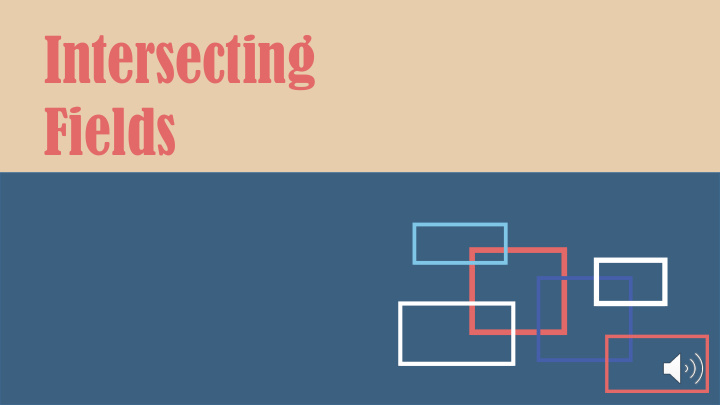



Intersecting Fields
Pr Proximal Reading a network-scaled approach to digital literature analysis Christopher B. Menadue ORCID ID: orcid.org/0000-0003-4794-8280 Intersecting Fields Conference 01 November 2017 Townsville, JCU CASE
Near, Far, Wherever You Are… The application of quantitative techniques to aid text analysis in the literary humanities From Burrow’s Conjectures into Criticism (1987) to Franco Moretti’s Graphs Maps and Trees (2005), and beyond…
near close reading the New Critics: I.A. Richards and followers Each of the New Critics emphasized his own set of concerns and priorities… even at the New Criticism’s height, the New Criticism was wrongly perceived as unified and consistent in its approaches (Gang, 2011)
far distant reading Franco Moretti, and followers Far from opening new perspectives, distant reading may actually blunt our critical faculties, inviting us to inadvertently adopt biased views of literature under the mask of objectivity. (Ascari, 2014)
far out… Unlike most of his critics, Moretti is therefore aware that a theory cannot be falsified by empirical facts… Like any proper theory, Moretti’s is the strongest where it seems the weakest... (Habjan, 2012)
wherever you are… proximal reading We can change our parameters and our questions simply by reading more: more widely, more deeply, more eclectically, more comparatively. Browsing in addition to quantification; incessant rather than distant reading: the unsystematic nature of our discipline is actually its salvation (Trumpener, 2009)
degrees of separation …and the random walk
Three Lots… You are going to One Two Four need a bigger research group Degrees of Separation
intersecting lines rhizomes slices granules temporality
applied digital humanities what do we want to know? what can literature tell us about it? what are the limitations?
corpus text …internally and self-referentially consistent ...defines research scope ...reader characteristics are distinguishable
science fiction as a text corpus there is an interdisciplinary research relationship between science fiction and human culture (Menadue & Cheer, 2017)
science fiction magazines bounded scope and unbounded content changes in recurring themes and ideas reflect social and cultural change (Menadue, 2017) advertising, letters and editorials: outward reading content (Scholes & Wulfman, 2010)
analysing the science fiction magazine
proximal reading your research project here boring exciting explore classify texts findings select corpus decide on degrees of theme content style separation prepare corpus texts just right interpret findings assess text ask research output question tell everyone who will listen too much too little
digital tools for non-specialists Excel for statistics and cataloguing Google forms for surveys Nvivo or other CAQDAS wordcloud generators
summary it’s (not so) complicated literary corpus text is a good place to look for cultural insights computers count and sort much more quickly than humans, but humans are better at interpretation quantitative, empirical methods eliminate selection bias qualitative analysis discovers meaning Integrating both is a logical approach to text analysis
References Ascari, M. (2014). The Dangers of Distant Reading: Reassessing Moretti's Approach to Literary Genres. Genre, 47 (1), 21-53. doi:doi:10.1215/00166928- 2392357 Burrows, J. F. (1987). Computation into criticism: a study of Jane Austen's novels and an experiment in method . Oxford: Oxford University Press. Fielding, N. G., and R. M. Lee. 2002. New patterns in the adoption and use of qualitative software. Field Methods 14 (2): 197–216. Gang, J. (2011). Behaviorism and the beginnings of close reading. ELH, 78 (1), 1-25. Habjan, J. (2012). The Bestseller as the Black Box of Distant Reading: The Case of Sherlock Holmes. Primerjalna Knjizevnost, 35 (1), 91. Menadue, C. B., & Cheer, K. D. (2017). Human culture and science fiction: a review of the literature, 1980-2016. SAGE Open, 7 (3), 2158244017723690. doi:10.1177/2158244017723690 Menadue, C. B. (2017a). Trysts tropiques: the torrid jungles of science fiction. eTropic, 16 (1), 125-140. doi:10.25120/etropic.16.1.2017.3570 Moretti, F. (2000). Conjectures on world literature. New Left Review 1 (Jan-Feb), 54-68. Moretti, F. (2005). Graphs, maps, trees: abstract models for a literary history . New York;London;: Verso. Scholes, R., & Wulfman, C. (2010). Modernism in the Magazines: An Introduction : Yale University Press. Trumpener, K. (2009). Critical Response. I. Paratext and Genre System: A Response to Franco Moretti. Critical Inquiry, 36 (1), 159-171. doi:10.1086/606126 Figures and Images Bollen J, Van de Sompel H, Hagberg A, Bettencourt L, Chute R, et al. (2009) Clickstream Data Yields High-Resolution Maps of Science [image]. PLoS ONE 4(3): e4803. Retrieved from: http://dragonfly.hypotheses.org/202/journal-pone-0004803-g005 Burton, Carl (2017). Slide backgrounds [gifs]. Retrieved from: http://carlburton.tumblr.com/ Network (n.d.)[gif]. Retrieved from: https://www.pinterest.com.au/pin/497295983834882617/?lp=true Prevos, P. (2012). Kinship Boundaries in the Southern Dutch Village of Heugem in 1796 [kinship network image]. In Frontiers in Genealogy and Heraldry . Presented at the XXXth International Congress for Genealogical and Heraldic Sciences, Maastricht. Retrieved from: https://nl.prevos.net/heugem/kinship/
Recommend
More recommend